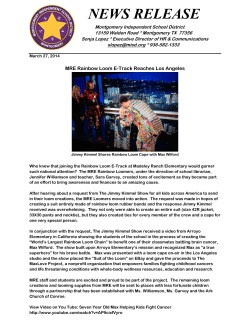
How to Assemble Your Kiss Loom
How to Assemble Your Kiss Loom by Robin McCoy Thank you for the purchase of the Kiss Loom! You are about to embark on a wonderful journey that could possibly cause you to give away or sell all your other looms. So, WHAT IS ALL THIS STUFF?! Take a deep breath and relax as I explain what each item is for. *Front-pegs and back-pins: You will use these together on everything except for when you have assembled a board. The pegs always sit in front of the pins and by adjusting the distance between them by using washers you will achieve different gauges. *Screws: You will use these to hold the front-pegs and back-pins together. The 2“ screws are for the wood blocks when assembling the board. The 1” screws are for board assembly. *Hex nuts: These are put onto the screw as the very last step to hold your loom together. IMPORTANT: when using the hex nuts you must have all 10 washers on the screw. So whatever you aren’t using for gauge, put it on the head of the screw. *Washers: These are used to space the front-pegs and back-pins apart to obtain the gauge you want. *Straight and corner brackets: You will use the straight brackets if you are assembling more than one set of pegs and pins together in a straight line. The corner brackets are used when assembling your loom into a modular which is just like knitting on a round loom. *Wood blocks: These are used when assembling a board. They give the right amount of distance between the two sides of pegs so that your knitting will fall neatly through the center. *Pick tool: Every loom knitter’s constant companion. They come in all shapes and sizes, but they all do the same thing. Ok, now that you have familiarized yourself with the components, how about we discuss the settings of the Kiss Loom? This setting is really good with light weight yarns. Weight #1, #2, #3 and some finer #4 yarns are good on this setting. This setting is good for medium weight yarns, such as worsted weight. Weight #4 and #5 are good on this setting. This setting is good for super bulky yarns or if you want to use two strands of worsted weight yarn together. It is good with weight #6. ***This setting will NOT work when loom is assembled as a modular, but you can use the second setting with all the washers placed between the peg and pin boards. Now that you know what the settings are, you are probably curious about how to put it together. Have no fear because you are about to learn. Assembly of a Kiss Loom modular using hex nuts This is what your end product will look like. It is exactly like using a round knitting loom. Let’s see what you will need: Assembly of Kiss Loom as a knitting board Y our Kiss Loom was sent to you with parts to make it into a double sided knitting board! How cool is that?! Here is what you need to gather: And you can assemble it for 3 different gauge settings. Now, let’s assemble! If you need to assemble more than one flat piece together to achieve the number of pegs needed on each side, do that first, then go on to step one.
© Copyright 2025





















